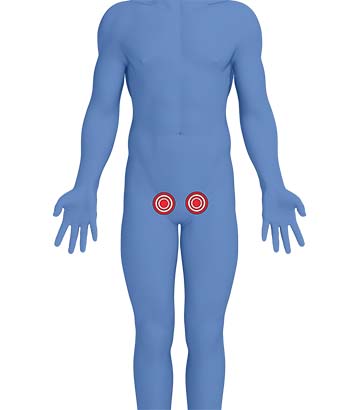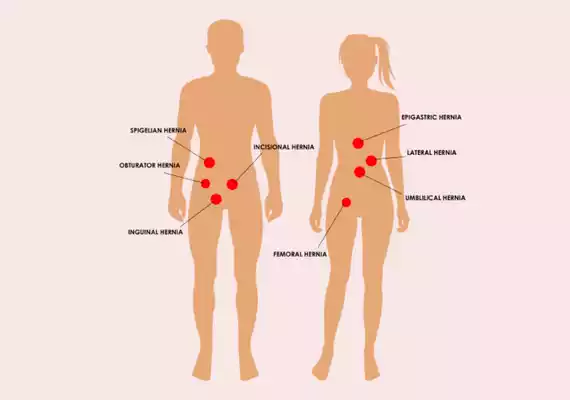Introduction of Inguinal Hernia and Femoral Hernia
Inguinal Hernia and Femoral Hernia are prevalent types of hernias that occur in the groin region. A hernia manifests when an internal part of the body, like an organ or fatty tissue, protrudes through a weak spot in the surrounding muscle or connective tissue.
The groin, a complex area where the abdomen meets the thigh, is susceptible to hernias due to its multiple weak points and the stress it undergoes. Inguinal hernias specifically arise in the inguinal canal, while femoral hernias form in the femoral canal near the upper thigh.
Each type has distinct risk factors, presentations, and implications, but their close proximity often leads to confusion. Proper differentiation is vital as treatment strategies and potential complications can vary based on the hernia type.
Definition of Inguinal Hernia
An inguinal hernia occurs when tissue, often part of the intestine, protrudes through a weak spot in the inguinal canal, which is situated in the groin. There are two primary types: 1. Direct and 2. Indirect.

Direct inguinal hernias emerge from a weakness in the abdominal wall’s muscle, typically manifesting in adulthood, whereas indirect inguinal hernias result from the failure of the inguinal canal to close completely during development, which can be present from birth.
Indirect hernias follow the path of the descending testis and are more common than direct hernias. The bulge from an inguinal hernia is often visible and can cause discomfort, especially during activities like lifting, bending, or coughing.
Definition of Femoral Hernia
A femoral hernia is a protrusion of tissue, often a segment of the intestine, through the femoral canal. This canal is located just below the inguinal ligament, near the groin’s crease and the upper part of the thigh.

Unlike inguinal hernias, femoral hernias are more common in females due to the wider shape of the female pelvis. The femoral canal, being narrower than the inguinal canal, poses a higher risk of complications for femoral hernias.
The presenting symptoms include a lump in the upper thigh or lower groin region, which can be accompanied by pain or discomfort. In certain cases, these hernias might be asymptomatic, making them harder to detect.
Causes and Risk Factors
Inguinal and femoral hernias arise from a combination of muscle weakness and increased intra-abdominal pressure. Key causes and risk factors include:
- Congenital Factors: Inborn weaknesses can predispose individuals, especially in indirect inguinal hernias.
- Age: Tissues naturally weaken with age, increasing susceptibility.
- Physical Strain: Heavy lifting or strenuous activity without proper technique can initiate hernias.
- Pregnancy: The increased pressure during pregnancy can contribute to femoral hernias in women.
- Previous Surgeries: Surgeries near the groin can weaken the region, heightening hernia risks.
- Chronic Conditions: Persistent cough, constipation, or prostate issues increase intra-abdominal pressure, contributing to hernia development.
Key Difference Between Inguinal Hernia and Femoral Hernia
Here’s a simplified comparison chart with nine rows for Inguinal and Femoral Hernias:
| Aspect | Inguinal Hernia | Femoral Hernia |
|---|---|---|
| Location | Groin | Below inguinal ligament |
| Gender Predominance | More common in males | More common in females |
| Risk Factors | Male gender, advancing age, family history, chronic cough/straining | Female gender, obesity, pregnancy, chronic constipation |
| Signs and Symptoms | Groin swelling, discomfort, pain (may descend into the scrotum in males) | Groin swelling, discomfort, pain (less likely to descend) |
| Diagnosis | Physical examination, imaging (ultrasound, CT) | Physical examination, imaging (ultrasound, CT) |
| Treatment Options | Watchful waiting, hernia truss, surgical repair | Surgical repair (herniorrhaphy or hernioplasty) |
| Complications | Incarceration (trapped hernia contents), strangulation (rare but serious) | Strangulation (blood supply cut off), bowel obstruction |
| Prevalence | More common type of hernia | Less common type of hernia |
| Prognosis | Generally favorable with treatment | Prompt surgical repair is crucial for a better prognosis |
Diagnostic Techniques
Accurate diagnosis of inguinal and femoral hernias begins with a comprehensive physical examination. The doctor palpates the groin region, observing any protrusion when the patient stands, coughs, or strains.
Since both hernias are present in the same area, differentiation is essential. Inguinal hernias generally appear above the inguinal ligament, while femoral hernias are below.
If the clinical examination is inconclusive, imaging tests might be ordered. An ultrasound offers a non-invasive means to visualize the hernia’s position and contents. In more complex cases, CT scans or MRIs provide detailed images, assisting in distinguishing between the two types and assessing potential complications, like strangulation or bowel obstruction.
Treatment and Management
Both inguinal and femoral hernias often require surgical intervention, especially if symptomatic or enlarging.
The two primary surgical methods are:
- Open Repair: An incision is made near the hernia site. The herniated tissue is repositioned, and the weakened area is reinforced, usually with a synthetic mesh.
- Laparoscopic Repair: A minimally invasive procedure involving multiple small incisions. A laparoscope guides the surgeon in repairing the hernia.
While both hernias can be treated with these techniques, femoral hernias, due to their higher risk of complications, may necessitate more urgent intervention.
Prevention Tips
Preventing hernias primarily revolves around minimizing strain on the abdominal and groin areas.
Recommendations include:
- Lifting Properly: Engage your legs instead of your waist when lifting heavy objects, and avoid bending over from the waist.
- Weight Management: Maintain a healthy weight, as obesity can increase intra-abdominal pressure.
- Dietary Choices: Consuming a fiber-rich diet aids in preventing constipation, and reducing the strain during bowel movements.
- Avoid Smoking: Smoking weakens tissues and can lead to chronic coughing, a known risk factor for hernias.
- Exercise Regularly: Strengthen abdominal muscles with exercises like planks and leg raises, but avoid intense crunches or exercises that strain the groin.
Summary
Inguinal and femoral hernias are both groin hernias, but they differ in their origin and risk factors. Inguinal hernias, stemming from the inguinal canal, can be either direct or indirect and are more prevalent in males.
Femoral hernias arise from the femoral canal and are seen more frequently in females. Both types result from tissue protruding through weak areas, leading to visible lumps and potential discomfort. Accurate identification is crucial, as each hernia type has distinct implications for treatment and potential complications.

